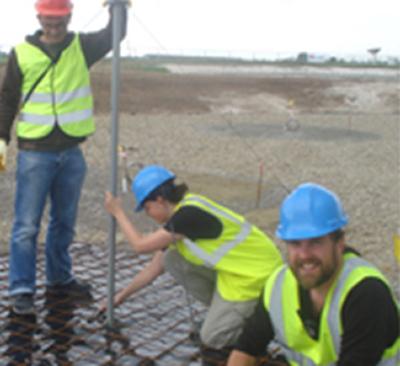New radio telescope will listen to the Universe on the FM-band

The first major radio telescope to be built in Britain for many decades will 'listen' to the sky at FM frequencies, providing vast quantities of data to a supercomputer in Holland, paving the way for unexpected new discoveries.
Astronomers, including scientists at the University of Southampton, hope to detect when the first stars were formed and will observe some of the most distant galaxies, revealing more about how the Universe evolved.
The telescope is being constructed this week (June 7-11) by a band of university volunteers in a field at the Chilbolton Observatory, near Andover in Hampshire, which is part of the Science and Technology Facilities Council (STFC).
Students, lecturers and researchers mainly from the universities of Southampton, Portsmouth and Oxford are helping scientists at Chilbolton to install 96 radio antennae, which are part of the European LOFAR project (Low Frequency Array). When completed, LOFAR will consist of over 5,000 separate antennae spread in 'stations' all over Europe. Stations have already been completed in the Netherlands and Germany and others are planned in France and Sweden.
Professor Rob Fender, of the University of Southampton, who is leading the LOFAR-UK project, says: "LOFAR is an amazingly simple concept because the antennae are made from everyday components, but it is also immensely complex because of the huge amounts of radio data that these antennae produce."
The antennae will work at the lowest frequencies accessible from the Earth and will be connected using sophisticated computing and high speed internet. A supercomputer based in the Netherlands will use digital electronics to combine the signals from the antennae across Europe to make images of the entire radio sky.
All the data-streams will be combined to make the world's largest and most sensitive radio telescope. Astronomers shift and multiply these streams together to improve the signal from them all and 'digitally steer' the telescope to different parts of the sky.
Rob adds: "At the Chilbolton site, seven petabytes of raw data will be produced each year, which must be transferred in real-time to Holland. That's like streaming 100 high definition TV channels for every second of every day for the next five years."
Professor Bob Nichol, of the University of Portsmouth's Institute of Cosmology and Gravitation and LOFAR-UK, says: "The LOFAR telescope will produce an enormous volume of data which in turn will enable a significant amount of science; from monitoring the sun's activity - 'space weather' to scientists - to potentially searching for alien intelligence - maybe answering the age-old question 'Are we alone?'."
LOFAR-UK is a consortium of astronomers representing 22 British universities, making it the largest radio astronomy consortium in the country. Over 70 leading UK astronomers are directly involved in the project. The universities involved include: Aberystwyth, Birmingham, Cambridge, Cardiff, Durham, Edinburgh, Glasgow, Hertfordshire, Leicester, Liverpool John Moores, Kent, Manchester, Newcastle, Nottingham, Open University, Oxford, Portsmouth, Queen Mary, University of London, Sheffield, Southampton, Sussex, and UCL. Other participating organisations include RAL/Chilbolton and the Science and Technologies Facilities Council (STFC).
LOFAR-UK is funded through a collaboration of UK universities with the SEPnet consortium www.sepnet.ac.uk and the UK STFC. www.lofar-uk.org